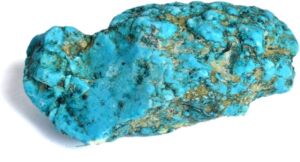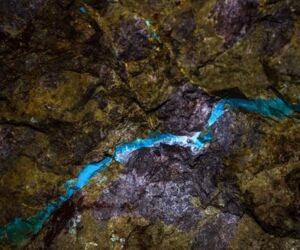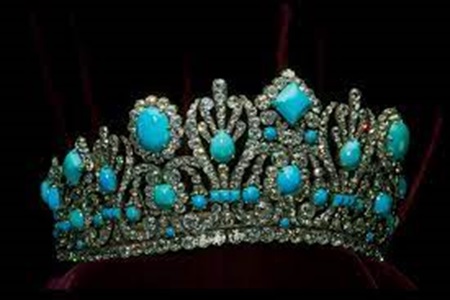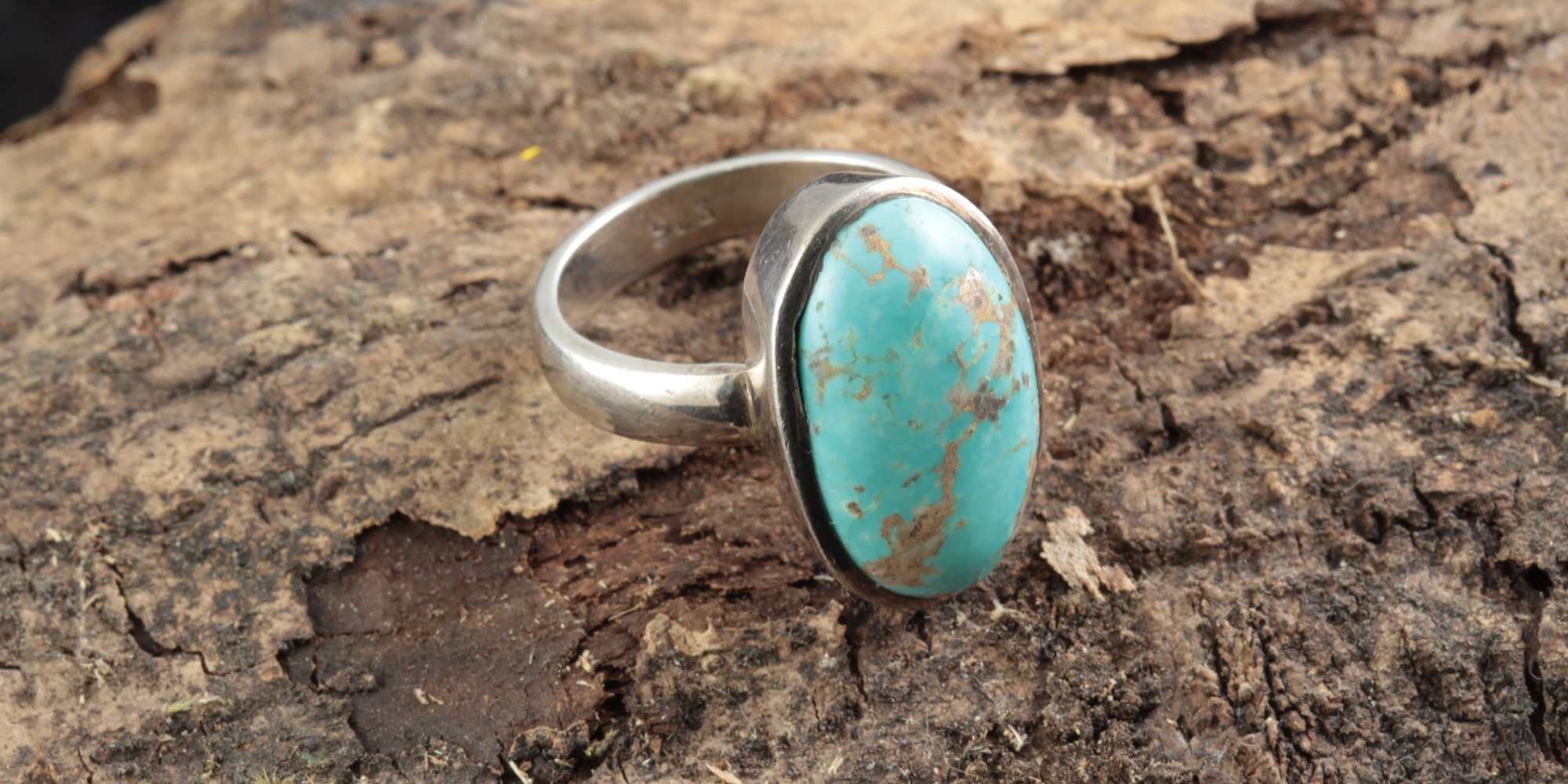Turquoise
Turquoise gemstone gets its name from the French word “pierre turquoise” which means Turkish stone. This name came about from the trade route that was taken by the Venetian merchants who brought the gemstone to France. This is despite the fact that the stone originated in Persia (modern-day Iran ). The gemstone is found in a range of clours from sky-blue to blue-green to apple green. With a pure medium blue being the most valuable, often called ” Robin`s egg blue” or “Persian blue”. Most turquoise however is interspersed with brown, dark grey or black veins of the host rock. It can also sometimes be intergrown with malachite or chrysocolla.
Turquoise Composition:
 Turquoise gemstone is formed when mineral-rich water seeps through fissures in the rock. Gradually over time some of the mineral content in the water is deposited and builds up to become a vein. Its chemical composition is a hydrous phosphate of copper and aluminum. It is the copper that is responsible for giving the gemstone its blue colour. If there are small amounts of iron present in the mineral-rich water, they will give the gemstone a greenish colour. Most Turquoise is formed in and around the host rock. Which leds to typically brown, grey or black inclusions in the gemstone known as matrix. When evenly distributed this matrix can form beautiful patterns called spider-webbing and can be very attractive. However as a general rule, pure blue Turquoise without any matrix is the most desirable.
Turquoise gemstone is formed when mineral-rich water seeps through fissures in the rock. Gradually over time some of the mineral content in the water is deposited and builds up to become a vein. Its chemical composition is a hydrous phosphate of copper and aluminum. It is the copper that is responsible for giving the gemstone its blue colour. If there are small amounts of iron present in the mineral-rich water, they will give the gemstone a greenish colour. Most Turquoise is formed in and around the host rock. Which leds to typically brown, grey or black inclusions in the gemstone known as matrix. When evenly distributed this matrix can form beautiful patterns called spider-webbing and can be very attractive. However as a general rule, pure blue Turquoise without any matrix is the most desirable.
Turquoise Mines
 The gemstone was first mined on the Sinai peninsula of Egypt around 6,000 BC. The stone found here is a bright greenish blue with a webbing of red and copper colour veins running through it. Which makes Egyptian Turquoise quite unique and identifiable. Mining still continues on the Sinai peninsula to the present day.
The gemstone was first mined on the Sinai peninsula of Egypt around 6,000 BC. The stone found here is a bright greenish blue with a webbing of red and copper colour veins running through it. Which makes Egyptian Turquoise quite unique and identifiable. Mining still continues on the Sinai peninsula to the present day.
Persian Turquoise found in Northeastern Iran, also called the “Jewel of the Orient”. Is considered the finest quality, know for its pure clear sky blue to rich dark blue colourations. Mining in the Nishapur region of Iran dates as far back as 2100 BC and has been intensively mined in the area since the 10th Century.
Turquoise has been mined in the Hebei province of China dating as far back as 1700 BC. Chinese Turquoise is typically characterised by its dark brown or black host rock and its beautiful spider webbing.
Turquoise was discovered in North America by the Native Indians about 200 BC. Although the gemstone is found all over North America, the best deposits have always been in Arizona and Nevanda.
Additional deposits of the gemstone are found in Afghanistan, Argentia, Australia, Brazil, Israel, Mexico and Tanzania.
Famous Turquoise Jewellery

Marie Louise Diadem

The Persian Turquoise Tiara

Turquoise Tiara by Cartier 1936
History & Lore
 This gemstone was widely used in jewellery, amulets and burial objects including the famous death mask of Tutankhamun in Ancient Egyptian. The Egyptians associated the gemstone with the goddess Hathor, often called the “Mistress of Turquoise”. Hathor was the sky goddess and was associated with joy and fertility.
This gemstone was widely used in jewellery, amulets and burial objects including the famous death mask of Tutankhamun in Ancient Egyptian. The Egyptians associated the gemstone with the goddess Hathor, often called the “Mistress of Turquoise”. Hathor was the sky goddess and was associated with joy and fertility.
In ancient Greece, the stone symbolized purity and was typically worn by young women. The Romans associated the stone with Venus, the goddess of love. They wore it on a Friday, which was the sacred day of Venus.
The use of this gemstone dates back to about 500 BC in Eastern Europe. While in Western Europe it didn`t become popular until the 17th Century. When Venetian merchants first introduced the stone. Although there was a small amount brought back by the Crusaders in the 11th and 12th Centuries. During the Renaissance, it was a popular stone in men`s signet rings and also for use in decorating religious objects.
Throughout history, Turquoise gemstone has symbolized good fortune, healing, and protection. The gemstone was said to have the ability to change colour and so warn of imminent danger. It was also said to protect the wearer from falls, particularly falls from a horse. It was believed that by placing the gemstone on the bridle of a horse, both horse and rider would be protected from falls.
Care and Maintenance
Turquoise can change colour and become a dull shade of green when heated to above 250 degrees celsius. So care is needed if you are having repairs done to your jewellery that involve heat such as soldering. This stone can also negatively change colour if exposed to direct sunlight for prolonged periods or if it comes into contact with household detergents or certain cosmetics. For this reason, it is always best to remove your jewellery before you wash or shower. Due to its porous nature, this gemstone is not suitable for steam cleaning or ultrasonic cleaners. To clean it is best to only use a lint-free microfiber cloth, slightly dampened with clean lukewarm water. Rub the gemstone gently and then dry, again with a lint-free microfibre cloth. Turquoise has a rating of 5 to 6 on the Mohs scale of hardness, which is classed as relatively soft. As such it is not suitable for everyday use, but rather for special occasions.
You can also get in touch with Carusjewellery.com on Facebook , were you may leave any comments or questions you have about this article.

